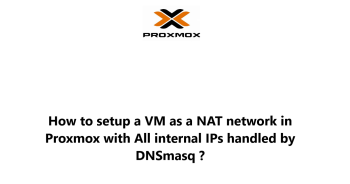Error Spawn Sendmail ENOENT - How to fix this issue ?
In fact, the error message Error: spawn /usr/sbin/sendmail ENOENT can occur for a few reasons.
If you are getting this error, you can try the following steps to resolve it:
- Check if the sendmail command is installed.
- If the sendmail command is not installed, install it using your package manager.
- Once the sendmail command is installed, add it to the system path.
- Check if you have permission to execute the sendmail command. If you do not have permission, change the permissions so that you do have permission.
We hope this helps! Let us know if you have any other questions.
How to setup a VM as a NAT network in Proxmox with All internal IPs handled by DNSmasq ?
In this guide, you have learnt how to configure DNSmasq to provide DHCP service and how to configure Pi-hole to use DNSmasq as its upstream DNS server.
By following these steps, you can easily create a private network for your virtual machines that can access the internet and have their DNS requests resolved by Pi-hole.
Set Up and use and DNS for Virtual Machines on a NAT Network in Proxmox - How to do it ?
In this guide, we showed you how to set up virtual machines on a NAT network in Proxmox.
How to Create Mind Maps Within the Linux Terminal With h-m-m (Hackers Mind Map) ?
This article covers how to install and use h-m-m to create mind maps within the Linux terminal. We also discussed how to uninstall h-m-m if you no longer wish to use the program.
With h-m-m, you can create powerful and useful mind maps within the Linux terminal.
How Chmod 777 works
This article will guide you on how to give #Chmod 777 to folders and files in #Linux. We also discussed the risks and more information about file permissions.
If you are managing a Linux system, it is crucial to know how the Linux #permissions work.
You should never set 777 (rwxrwxrwx) permissions #files and #directories permissions. 777 means that anyone can do anything with those files.
To Give Root Privileges to a User in Linux:
1. Adding to Root Group using usermod. Let see how we can grant normal user root access by adding to root group.
2. Adding to #Root Group using Useradd Command.
3. Editing /etc/passwd file.
4. Setting as Sudo User.
Add User To Group in Linux
This article will guide you on how to add a #user to a #group in #Linux. The group permissions apply only to the group that has been assigned to the file or directory, they will not effect the actions of other users. The others permissions apply to all other users on the system, this is the permission group that you want to watch the most.
Groups can be thought of as levels of #privilege. A person who is part of a group can view or modify files belonging to that group, depending on the permissions of that file. User belonging to a group has privileges of that group, for example - sudo groups lets you run software as super user.
To view all groups present on the system simply open the /etc/group file. Each line in this file represents information for one group. Another option is to use the getent command which displays entries from #databases configured in /etc/nsswitch.
To Create a New Sudo User:
1. Log in to your server as the root user. #ssh root@server_ip_address.
2. Use the adduser command to add a new user to your system. Be sure to replace username with the user that you want to create.
3. Use the usermod command to add the user to the wheel group.
4. Test sudo access on new user account.
To List Users in Linux:
i. Get a List of All Users using the /etc/passwd File.
ii. Get a List of all Users using the getent Command.
iii. Check whether a user exists in the Linux system.
iv. System and Normal Users.














